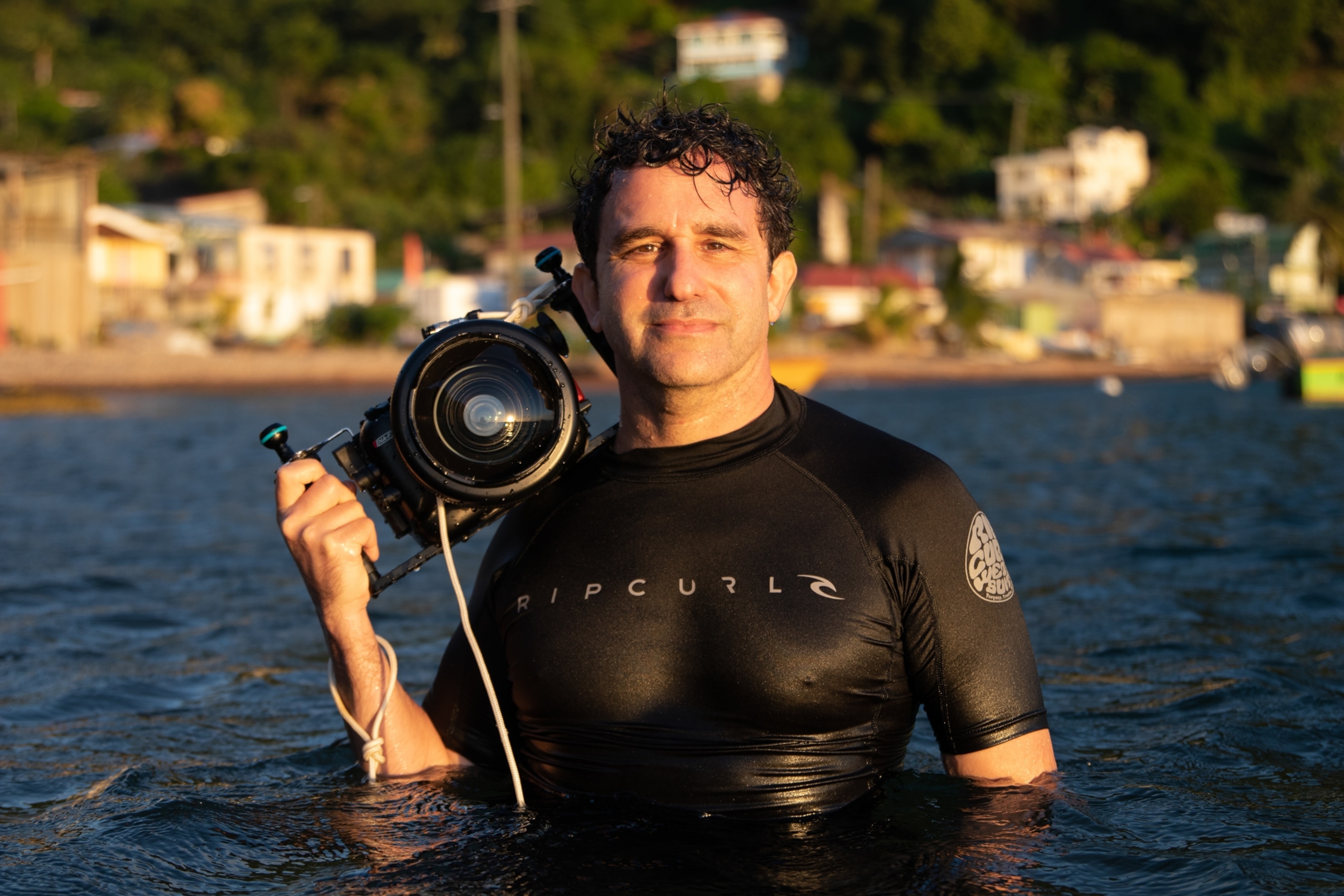Two summers ago, in the turquoise waters off the coast of a small Caribbean island called Dominica, a sperm whale named Rounder began to give birth. Eleven members of her clan slowly gathered around to support her, converging from miles away in their home waters. They called to one another in choruses of Morse code-like clicks as they waited for the baby to arrive and in the hours that followed, when they held the calf above water so that she could breathe, only lowering her when her fins finished unfurling. Soon after, they departed.
Scientists are developing innovations in recording and analyzing sperm whale communications that could someday make it possible to understand at least some of what whales say to each other in these extraordinary moments. People might translate what they only now surmise: expressions of care and joy, arrangements of duties, cries of pain and discomfort. With those translations would come profound and surprising legal questions.
Might a richer understanding of what sperm whales say breathe new life into laws that presently offer only incomplete, often-unenforced protections? Could legal systems recognize whales as persons, their interests so important as to be accorded formal rights? “I think we’re just now on the cusp of this immense legal world,” says David Gruber, a marine biologist and National Geographic Explorer.

Scientists with Project CETI use machine learning software to find patterns within the rapid clicks that comprise sperm whale vocalizations. This research may lead to a deeper understanding of their language.
Photograph By Franco Banfi, Nature Picture Library
Gruber is the founder and president of Project CETI (Cetacean Translation Initiative), which has gathered dozens of linguists, biologists, roboticists, and experts in artificial intelligence to document the lives and communications of Dominica’s sperm whales. Their work builds on several decades of findings in the field of animal communication—not only in sperm whales but throughout the animal world, from songbird syntax to chimpanzee gestures and river turtle repertoires. Gruber’s team is working to translate whale conversation with an unprecedented richness and detail. They hope to eventually develop a quasi–Google Translate for cetaceans, which would convert sperm whale sounds into human language and vice versa.
Already, Gruber and his colleagues are beginning to anticipate some of the legal implications of this work. In a new working paper that is expected to be published later this fall in the journal Ecology Law Quarterly, they note that one result might be a world in which humans “undeniably understand” these creatures’ experience from their own perspective. “Such insights could provide a groundwork for new laws and inform how existing laws regulate actions that impact cetaceans.”
To explore what might become possible, Gruber tapped a leading team of experts, including César Rodríguez-Garavito, director of the More-than-Human Rights Project at New York University; Ashley Otilia Nemeth, an attorney at NYU’s TERRA Clinic; and CETI linguistics lead Gašper Beguš of the University of California, Berkeley. They offer a new framework for thinking about the law that is rooted in the way whales experience the world.
Consider, for instance, the problem of ocean noise pollution. For creatures like sperm whales, who rely upon echolocation to find food and to navigate, and who remain in near-constant vocal contact with family and friends, sound is paramount. Humanity’s growing aquatic din—oil and gas exploration, construction, military sonar, and most of all ship engine noise—is a clear harm, disrupting the basic activities of sperm whale life.


Project CETI lead David Gruber, left, has brought together a world class team of experts in marine biology, robotics, artificial intelligence, and linguistics to better understand sperm whale communication.
Photograph By Michael Lees, CETI Project
“We have very good evidence of the impacts,” says Rodríguez-Garavito, yet that evidence has yielded piecemeal progress. The federal Marine Mammal Protection Act and the Endangered Species Act—the bedrock of cetacean protections in the United States—provide a legal framework for preventing harms, but government agencies have mostly neglected to apply rules against harming cetaceans to cases of noise-induced harm. The same toothlessness holds for other attempts to curb underwater noise, such as new regulations passed in the European Union and by the International Maritime Organization.
But what if whales were documented not only straining to make themselves heard above the racket, but actually talking about it? Were a sperm whale heard articulating the pain and difficulty caused by a ship’s eardrum-rattling, echolocation-scrambling engine noise, their words would likely carry more weight in a court of law than do human descriptions of the problem. Being able to present the whales’ own testimony, so to speak, might move—or shame—government agencies and judges to action. It “would help us make more of a convincing case,” says Rodríguez-Garavito, and a deeper understanding of sperm whale communication could inspire even farther-reaching legal claims.
Animal advocates and conservationists might be able to argue that near-constant physical and psychological stress caused by chronic noise pollution actually violate the spirit of international prohibitions against torture. Sensory deprivation and overstimulation are already recognized as torturous for humans; recognizing the same for whales could lead to new, more urgent protections.
Advocates could also assert that by disrupting communication and social activities, noise pollution interferes with sperm whale culture—and that the whales should qualify, again in spirit if not in letter, for recognitions afforded by the Universal Declaration of Human Rights, which enshrines a right to participation in cultural life.
After all, culture—socially transmitted information that is passed between generations—is already known to be a significant feature of sperm whale life. Different clans have different dialects, lifestyles, and social customs. Even when their waters overlap, clan members often keep to themselves, and their structure resembles that of human tribes. But those are coarse descriptions; to learn about the whales’ cultures through their own words would provide a finer understanding of them. It would put a sharper point on what is lost when humans destroy those cultures or remove individuals from them—by hitting them with ships, hunting them for profit, or capturing them for entertainment.
Perhaps that deeper, first-person understanding could again lead to new protections or reinforce existing ones. Maybe advocates will be able to call not merely for protections, but true rights: the explicit legal recognition of an interest as profoundly, inviolably important.
That leads to the topic of legal personhood, defined by the late Steven Wise, founder of the Nonhuman Rights Project, as the capacity to have any rights at all. In the United States, rights are exclusively human. No animal has ever been accorded a full legal right; although laws against cruelty and the mistreatment of animals provide some protections, they have neither the force nor versatility offered by rights.

A sperm whale socializes with its pod in the Caribbean Sea. In the near future, researchers may be able to gain a deeper understanding of these behaviors by being able to communicate directly with the animals, which could lend support to new forms of legal protection.
Photograph By Franco Banfi, Nature Picture Library
The Nonhuman Rights Project has tried to cross that legal divide by filing lawsuits seeking the release of captive chimpanzees and elephants. The lawsuits draw on scientific research showing how those species share the mental capacities—including rich forms of self-awareness, emotions, and society, and the ability to plan for the future and make choices—that in humans give rise to autonomy and thus underlie our right to be free from arbitrary imprisonment. As a matter of equality, Nonhuman Rights Project lawyers argue this right should be extended to chimpanzees and elephants as well.
You May Also Like
Courts have so far rejected that argument, and among their stated justifications is the idea that in order to have rights, one must also be able to bear social responsibilities and legal duties: the right to liberty comes with a duty not to break the law. Rodríguez-Garavito and his co-authors suggest that Project CETI’s work could illuminate how sperm whales negotiate their own social responsibilities, such as helping mothers deliver and protect their babies, thus establishing them as duty-bearers in the law’s eyes.

Project CETI teams members Darren Gibbons, Yaniv Aluma, and Odel Harve work from a Whale Listening Station floating in the Caribbean Sea. Such outposts are one of the innovations Project CETI has developed to help capture and analyze whale sounds.
Photograph By CETI Project
Translating the caregiving arrangements whales make with each other will not likely satisfy reluctant judges, though. Spencer Lo, an attorney with the Nonhuman Rights Project, noted that judges already dismiss scientific evidence of social responsibilities fulfilled by chimpanzees and elephants. Instead those animals are found wanting in their inability to explicitly understand human legal codes—an expectation that is not applied to babies or people with severe dementia, who are similarly unable to understand laws but still have rights. That double standard speaks to the essential discomfort most judges have with the idea of animal personhood. And even when courts don’t cite the “rights and duties” standard, they have found other rationales.
Those rejections are ultimately rooted in the belief that “humans are qualitatively—and thus morally and legally—distinct from all nonhuman animals,” says Lo. He thinks that Project CETI’s work, and that of other researchers deciphering complex animal communication, has “transformative potential,” but not because it will reinforce any particular legal argument. Rather, that potential resides in its power “to undermine human exceptionalism and thereby bolster the case for personhood.”
Yet despite their courtroom struggles, the Nonhuman Rights Project has arguably triumphed in the court of public opinion. Understanding sperm whale communication may not lead directly to new laws or precedents—but it should still nourish empathy and care.

A young calf swims alongside two adults off the coast of Dominica, where, in 2023, Gruber and his team became the first research group to document the birth of a sperm whale in the region. From that encounter, they hope to gain a richer understanding of pivotal moments in these animals’ lives.
Photograph By Brian Skerry, Nat Geo Image Collection
Even as U.S. courts have refused to recognize animals as persons, however, jurisdictions elsewhere have been more open-minded. In recent years, judges in several countries have declared that some animals should be considered persons; in Panama, for example, sea turtles now have a federally recognized right to freedom from human harm, and Ecuador’s highest court took the extraordinary step of declaring that all animals are legal persons. Discussion is now ongoing about the rights that each species deserves.
Kristen Stilt, faculty director of Harvard University’s animal law program, used the analogy of fluid flowing through pipes to illustrate how better understandings of animal communication could lead to legal change. In the United States, she says, new information flows through “a couple little straws,” but in places that are open-minded to animal rights, “it’s like you’ve got this massive pipe, and all this [information] can flow in all these different directions.”
Leading scientists and legal scholars are already considering the potential harms of this technology. “In the miraculous event that we do eventually ‘crack the code,’” says Philippa Brakes, a behavioral ecologist at Massey University in Australia, “there are issues such as the potential for communications with wildlife to be used for nefarious purposes.”
Gruber agrees and adds that technology developed by Project CETI and other researchers could be turned to ill not only by people who want to harm whales, but by well-intentioned yet careless people. He is especially troubled by the thought of people “racing to try some of these fancy new AI tools”—tools that not only translate whale communication but mimic it—without fully understanding what is being communicated.
“We must still grapple with the potential impacts of its research and what its findings may equip others to do,” write Gruber’s team. The possibility should be “understood as a clarion call for ethical and legal safeguards.”

A sperm whale calf swims near the surface of the Caribbean Sea. Translating the conversations of such animals may not immediately lead to new legal protections, but it shed light on challenges they may face.
Photogrpah By Brian Skerry, Nat Geo Image Collection
Stilt has even more fundamental reservations. If complex animal communication and our ability to translate it becomes the basis for ethical regard, a bar that animals must clear for their interests to be recognized, it would “take us backwards,” she says. That would give people an excuse for failing to act on what is already known about animals, the harms we cause, and how we should treat them, regardless of whether they speak in a suitably human-like way.
The Project CETI team shares those reservations too. “Why must nonhuman animals resemble humans for us to empathize with their pain and safeguard their well-being?” they write. “Must they articulate their suffering when we already possess a clear understanding of the injuries we cause?”
The quest to find and translate complex animal communication should not diminish the worth of creatures who don’t appear to have those capacities, says Rodríguez-Garavito. We may simply fail to appreciate their intelligence; and the lack of rich communication does not make any life less special. But it would still be incredible, and perhaps transformative, to know what sperm whales say—and this could be seen as an entry point, a beginning rather than a destination, on the journey to appreciating all creatures.











